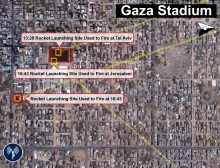The tragic on-again, off-again Gaza war with Israel is up in full force this week, but if you don’t live there, you may be wondering how this escalation is any different from ones in the past. But make no doubt about it, this is a whole new fight. Here’s why:
1. The Range of Gaza’s Rockets
Anyone who tries to pretend that the Hamas terrorist group has toy guns to fight Israel’s tanks hasn’t been paying attention to past skirmishes. Hamas has used anti-tank weapons and deadly rockets in the past. But this round has seen Hamas do something it has never really been able to do: strike at the heart of Israel.
According to the IDF Blog, rockets have repeatedly reached Israel’s capital of Jerusalem and major metropolis of Tel Aviv. To put that into perspective, that’s akin to rockets threatening Washington, D.C. and New York. While it’s not the first time the Israeli mega-cities have been threatened, it’s the worst it has been yet.
What’s more, the IDF Blog said that Zichron Ya’akov, two-thirds up the Israeli coastline, has had a rocket alarm siren sound. The IDF Blog reported that Hamas’ longest-range missile, the M-302, can reach as far as Haifa—Israel’s largest port city in the north.
To put it in perspective, Haifa was the largest threat to be targeted in the 2006 war with Lebanon, Israel’s northern neighbor. Hamas can now overlap the rocket range of Lebanon’s Hezbollah terrorists.
2. The Scale of Gaza Attacks and Israeli Response
All of Israel’s largest cities in the north and in the south are in range, and because of the range of Hamas’ missiles, that now puts even more Israelis under threat. At a minimum, the IDF Blog noted that over half of Israel’s population is now at risk. That’s actavis generic klonopin more than 3.5 million people.
Overall, Gaza terrorists have fired more than 365 rockets at Israel in just three days according to the IDF Spokesperson’s Twitter page, which points out that that is roughly one rocket every 10 minutes. Believe it or not, that’s actually fewer than the last conflict, although it’s still a stunning figure.
In response, Israel has targeted around 780 targets since the start of Operation Protective Edge, according to the IDF Blog. The IDF numbers are on pace to eclipse the final totals for the last war between the sides back in 2012. For that fight, Israel hit 1,500 terror targets in eight days—this one is on pace for over 2,000 targets to be struck.
3. The Politics Involved
The last time the sides fought, Hamas was still the arch-enemy of the Palestinian government’s leading party, Fatah. Palestinian President Mahmoud Abbas was legitimately distanced from Hamas as the head of Fatah, and in effect, there were two Palestinian governments.
Today, however, comes after Fatah signed a reconciliation deal with Hamas to include their say in the formation of a transitional government. Abbas and Fatah appear to be detached from the current fighting—which is still centered around Hamas’ base in Gaza.
But that does put Abbas in an awkward position. Furthermore, it proves that the sides’ alliance is superficial at best and calls into question its survivability.
Still, it does technically mean that a major faction influencing the Palestinian government is at war with Israel. It’s similar to one of the political factions in the US or Europe declaring war on a neighboring nation.
And of course, who isn’t condemning Hamas’ assault on Israel? Abbas and Fatah. Not that Abbas ever took Israel’s side publicly in fights with Hamas, but in this case, his association with them makes his silence seem more disturbing than usual.
(By Joshua Spurlock, www.themideastupdate.com, July 10, 2014)

